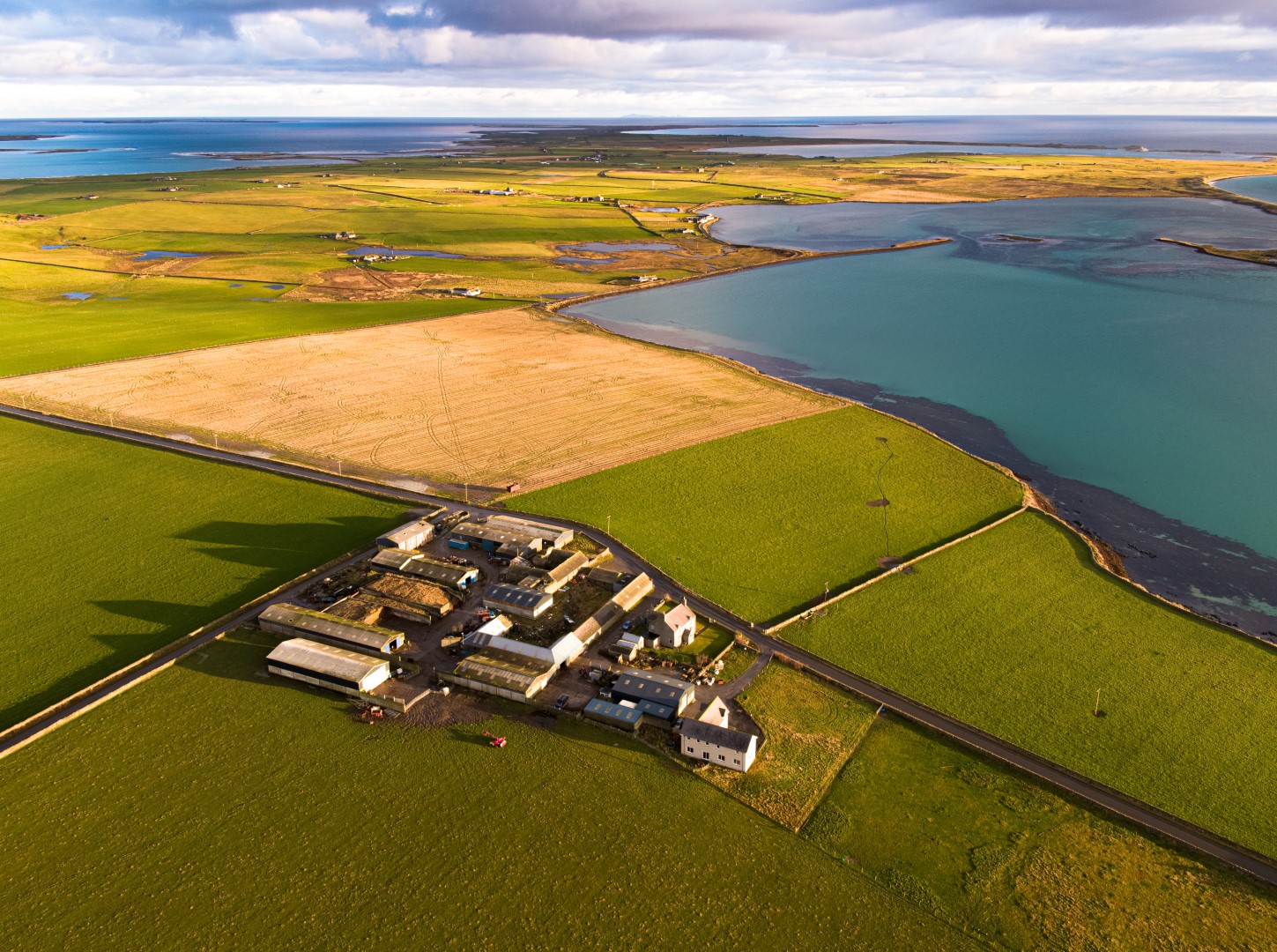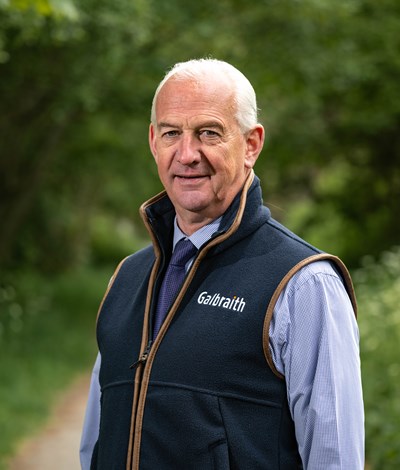The adjacent properties, How Farm and Backaskaill Farm offer outstanding potential to continue the established livestock and cereal business, as well as the successful 5-star holiday letting accommodation. In addition there is potential to develop a further tourism business on the land.
How Farm has a modern 4 bedroom farmhouse, a traditional 4 bedroom farmhouse, a hugely impressive range of traditional and modern farm buildings, and 574.66 acres (232.56 hectares) of land.
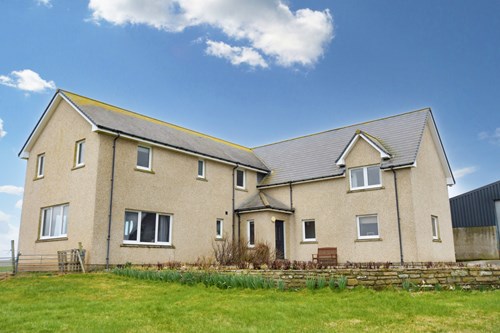
How Farm also includes Bea Loch covering 94.79 acres, which is stocked with wild trout, and beautiful beach frontage.
The adjacent Backaskaill Farm has a superb three- bedroom farmhouse, a beautifully renovated farm cottage, a range of traditional and modern farm buildings and 665.34 acres (269.26 hectares) of land as well as extensive beach frontage on an idyllic sandy beach.
Both farms are situated in a productive area on the breath-taking idyllic island of Sanday.
Currently benefitting from the Organic Aid Scheme, How has a carrying capacity of 200 cows and calves, 200 stirks, in addition to 300 breeding ewes. Backaskaill has a carrying capacity of 100 cows and calves, and 100 stirks, in addition to 150 breeding ewes. There is an ample land area on both farms for the growing of forage and cereal crops to sustain the current stocking rate.
Both farms currently benefit from a range of support payments including the Organic Aid Scheme, Basic Payment Scheme, Less Favoured Area Support Scheme, Scottish Beef Calf Scheme and the Agri-Environment Climate Scheme. The payments apportioned to How are forecast to generate an income of £105,000 for the 2024 scheme year, while payments to Backaskaill are forecast to generate an income of £110,000 for the 2024 scheme year.
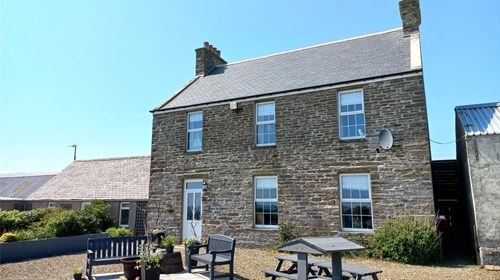
Backaskaill Farmhouse has been tastefully renovated and decorated to a very high standard and is currently let as 5-star holiday accommodation. The accommodation includes: Kitchen/dining room, utility room, hallway and bedroom with en-suite. Upstairs there are two further bedrooms, lounge and bathroom.
Backaskaill Cottage is also let as part of the award winning, five-star self-catering holiday business. The cottage has a lounge, conservatory, kitchen/diner, and bedroom with en-suite.
Tom Stewart of Galbraith, said: “This is a rare opportunity to acquire one, or both, of these productive farms, which form part of a highly successful rural business. The setting is absolutely beautiful, on one of the most stunning beaches in Scotland and the current owners have created a sustainable and diverse farming enterprise as well as the established 5-star holiday accommodation.
“There is the potential to further diversify and perhaps create an additional tourism business at How Farm, if desired. Orkney offers an outstanding rural lifestyle, tranquillity and superb quality of life, within easy reach of the mainland.”
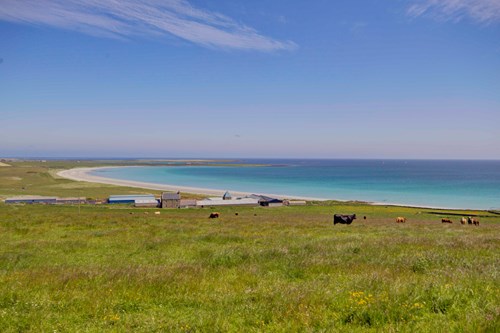
Included in the ownership of How Farm is the Bea Loch, which extends to approximately 95 acres, and 1,250 metres of sea shore on Backaskaill Bay. The potential for diversification opportunities of both the loch and the shoreline is considerable and includes wildlife photography, (Orcas often pass through the bay), sailing, boating, both sea and loch fishing, in addition to the wild fowling when in season.
Bea Ness Farmhouse is a modern, and well-presented farmhouse with good insulation throughout. The accommodation includes: dining kitchen, utility room, office, family room, dining room, lounge, WC, master Bedroom with en-suite, three further bedrooms, (one with en-suite) and main bathroom.
How Farmhouse is a traditional property with four/five bedrooms, and one reception room.
The productive farm land at How extends to 574.66 acres.
In addition there are some 154.34 acres of cliffs, fore shore, roads, yards and buildings, plus 94.79 acres, which is the Bea Loch.
According to the James Hutton Institute the majority of the land at How and at Backaskaill is classified as Grade 4(2) and Grade 5(2). The land at How is in good heart having been farmed in a grass rotation, with cereal and swede breaks in recent years and is fenced and watered. The land has benefited from regular applications of dung, slurry and shell sand which has a 32.5% lime content.
There is a hugely impressive range of traditional and modern farm buildings at How Farm including sheds, cattle courts, silage pits, byres, barns and grain stores.
Backaskaill Farm has a smaller range of traditional B-listed and modern farm buildings.
Orkney contains some of the oldest and best preserved Neolithic sites in Europe. The islands also have an abundance of marine and avian wildlife and are popular with tourists.
Kirkwall, the largest settlement in Orkney, has services including banks, supermarkets, sports centre and swimming pool. The area is well resourced in terms of agricultural infrastructure being well served by general merchants, agricultural suppliers and machinery dealers, in addition to Kirkwall Mart.
Sanday is the largest of Orkney’s outer islands and is well known for its rich, agricultural land and outstanding livestock. The island is blessed with stunning coastal scenery, long sandy beaches and benefits from a range of shops, primary and secondary schooling, hotels, a medical practice and a thriving community. There are excellent transport links by sea and air to the mainland.
-
How Farm, Sanday, Orkney Islands, is for sale through Galbraith for Offers Over £2,200,000
-
Backaskaill Farm, Sanday, Orkney Islands, is for sale through Galbraith for Offers Over £2,000,000.
